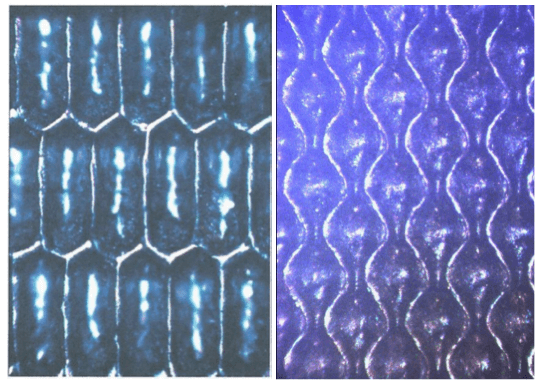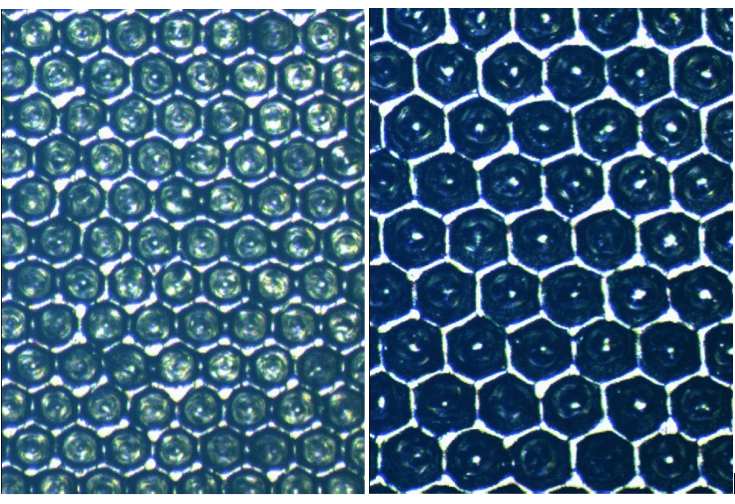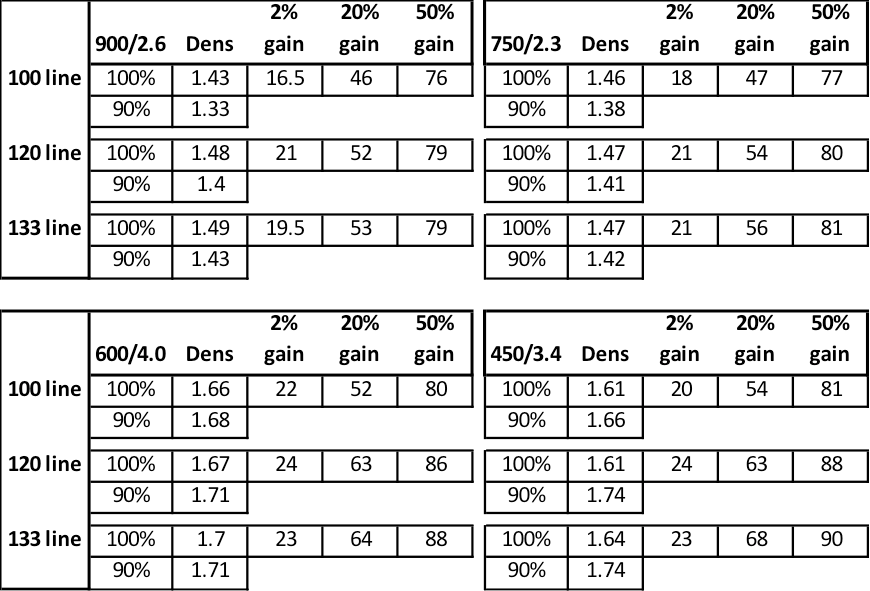Lower Your Line Screen and Cell Volume for Better Anilox Performance!
Authors: John Rastetter and John Bingham
It sounds counter-intuitive to lower your anilox line screen to improve performance but that’s exactly what we are proposing, read on for a detailed review of the logic and the results.
For years anilox producers have been recommending that printers increase the anilox line screen to improve print reproduction. The thought is that by increasing the anilox line screen more support is given to the printing plate, producing cleaner print. Increasing line screen does insure that more cell walls contact the plate, but what it primarily does is reduce the percentage of cell volume that is transferred to the printing plate. The lower transfer efficiency creates a thinner ink film. A thinner ink film in turn produces cleaner print. However, there are negative side-effects of increased anilox line screen ; plugged cells, scoring, and pre-mature wear.

On the left is the EFlo cell technology and the right the HourGlass cell, note the clean sharp cell formation created by fiber-optic laser technology
Pamarco feels there is a better way to produce the same, or improved print result and at the same time increase ink transfer consistency and anilox durability. This is accomplished by decreasing the anilox cell count and reducing cell volume to produce anilox engraving that provide the correct ink film thickness, more consistent ink transfer and an engraving that is more durable.
Today’s anilox technology utilizes fiber-optic, multi-beam, Thermal engraving technology. To be more specific, Instead of using a blend of gases, mirrors, and tubes to produce a single laser beam, a crystal creates a short pulse-length beam that is so powerful a single beam is split into as many as four smaller ones. The splitting of the beam is what currently enables anilox cells to be “multi-pulsed” or “multi-cycled” creating cells that are “carved” with precision. The end result is a great deal of heat and energy directed into the cell of an anilox within a very short time-frame.
The benefit of fiber-optic technology is the ability to produce a wider range of line screens (35 lpi to over2000 lpi), increased cell depth and increased volume per line screen. This fiber-optic technology also allows us to create cell bottom that are flatter, shallower and smoother than a comparable CO2 laser engraving. Software advances in conjunction with this laser technology allow us to produce new cell shapes like EFlo and HourGlass, these new cell designs add additional performance benefits as well. However, If not implemented correctly the down-side of this technology can be a reduction in cell durability (resistance to scratching, scoring, and premature wear).
Older CO2 technology typically burned / engraved cells with a single pulse and at a pulse-length much longer than fiber-optic technology. CO2 technology does not vaporize as much of the ceramic that is burned away to form the cell, leaving a rim of melted ceramic on the cell walls referred to as re-cast. Melted and re-hardened ceramic is believed to be harder than the “as sprayed” ceramic on the surface of the anilox. This recast assists with durability of the engraving. Fiber-optic technology, because it burns at a shorter pulse length creates recast in a different way, it tends to accumulate in nodules or posts at the corners of the cell. If cell geometry is not correctly established by utilizing an acceptable depth to opening ratio, the multiple pulses inside each cell can over harden the nodules, causing them to become brittle. The end result can be chipping or breaking of these particles, creating pre-mature wear and/or tiny scratch or wide score lines on the anilox.
Since the anilox industries implementation of Thermal lasers, the focus has been to increase anilox line screen and cell volumes. Where a 4.0 bcm may have been utilized at a 400 line screen, today it is common to produce the same volume at a line screen of 600 and higher. The 600 line screen at a 4.0 bcm produces cleaner print than a 400 line screen at a 4.0 bcm because less of the 4.0 bcm volume transfers to the printing plate. This is caused by the fact that deeper cells have a lower transfer coefficient. The resulting transfer produces Print that is cleaner, but density is reduced and engraving life is compromised. Pamarco thinks a better approach, in most cases, is to decrease the anilox line screen and cell volume to reduce the ink film thickness transferred to the printing plate. This will produce cleaner print, targeted ink densities and anilox cells that are more resistant to wear and plugging.

Above are photographs of the 450 lpi – 3.4 bcm and 600 lpi – 4.0 bcm engravings tested on the banded roll. Cell depth on the 450 was 15.5 microns with a 53.4 micron opening (29% depth-to-opening ratio) versus a cell depth of 20.3 microns with a 40.3 micron depth (50% depth-to-opening ratio). Note the improved smoothness of the cell walls on the 450 lpi
An example of this can be illustrated by a recent banded roll test. A test was done to determine if a better alternative is available to a 600 lpi, 4.0 bcm, 60° cell used by a customer for combination process/line work/solids printing and a 900 lpi, 2.6 bcm, 60° cell used for process print. To enable us to utilize a more durable lower line screen engraving, without sacrificing print cleanliness, it was necessary to also decrease the cell volume as we decreased the line screen.
Eight engravings were tested – 600 lpi – 4.0 bcm, 550 lpi – 3.8 bcm, 500 lpi – 3.6 bcm and 450 lpi – 3.4 bcm for combination print and a 900 lpi – 2.6 bcm, 850 lpi – 2.5 bcm, 800 lpi – 2.4 bcm and a 750 lpi – 2.3 bcm for process print. The end result was, by reducing both line screen and volume, all four engravings in each category produced nearly identical density and dot gain results. The advantage of utilizing the lower line screen and volume engraving is the cell surface is much smoother and it will transfer its volume more consistently.

The table above shows the results of the highest and lowest LPI for each application, please note the LPI, BCM, density and dot gain results for each.
In addition, Pamarco believes engravings used with steel doctor blades should be diamond film polished after engraving using a precision mechanical process. This process removes the nodules and creates a flat, smooth surface that is resistant to wear. All of our engravings used with steel doctor blades receive this process. In addition by utilizing lower cell count and volume ratios this process can be done with much more successful and repeatable results. Cell walls are flatter, smoother, and narrower, allowing for greater durability while insuring consistency in ink transfer and print performance.
The anilox’s “job” is to transfer a precise, predictable, and consistent ink film to the printing plate. The ink film is determined by the cell volume, not the line screen. It may be time to re-think the specifications of this import tool for greater long-term printing performance, consistency and durability.
For more information about Pamarco or for help acquiring the correct specifications for your anilox rolls, please call us at 404-691-1700.
